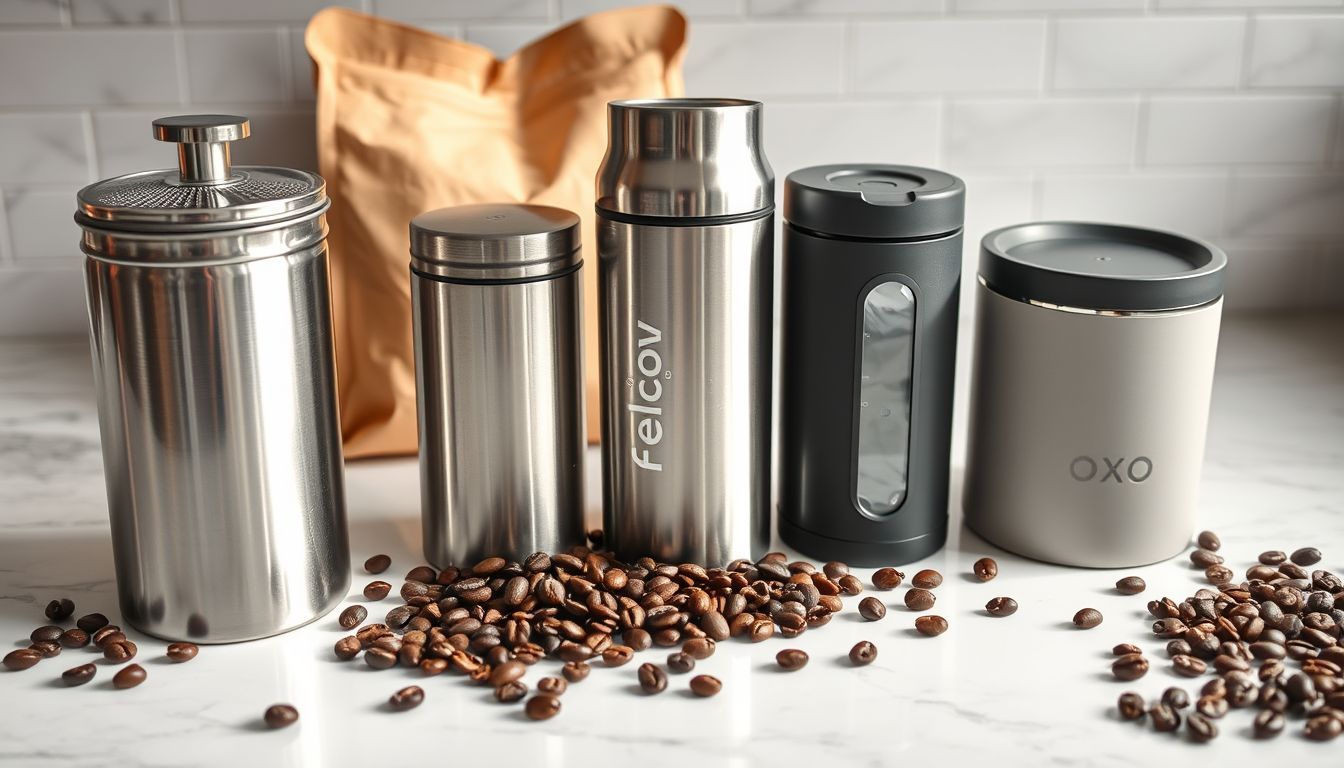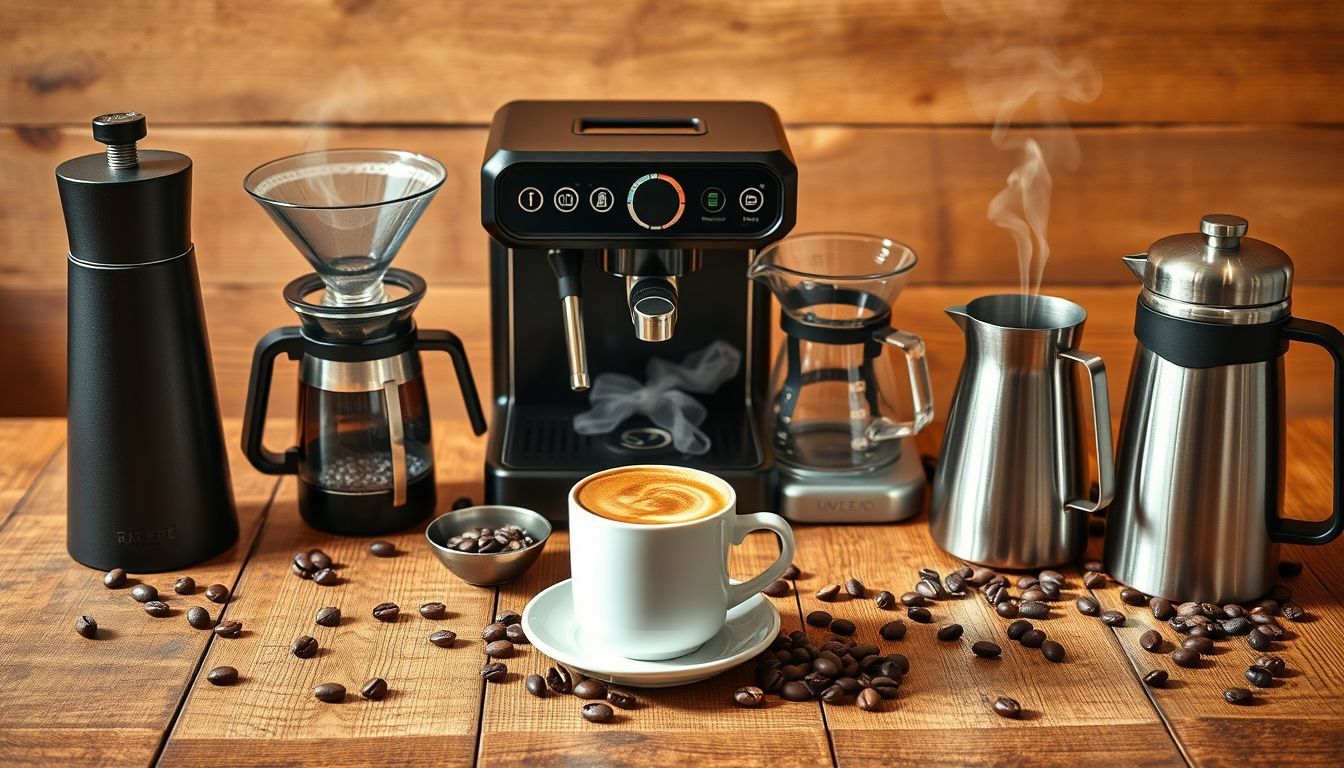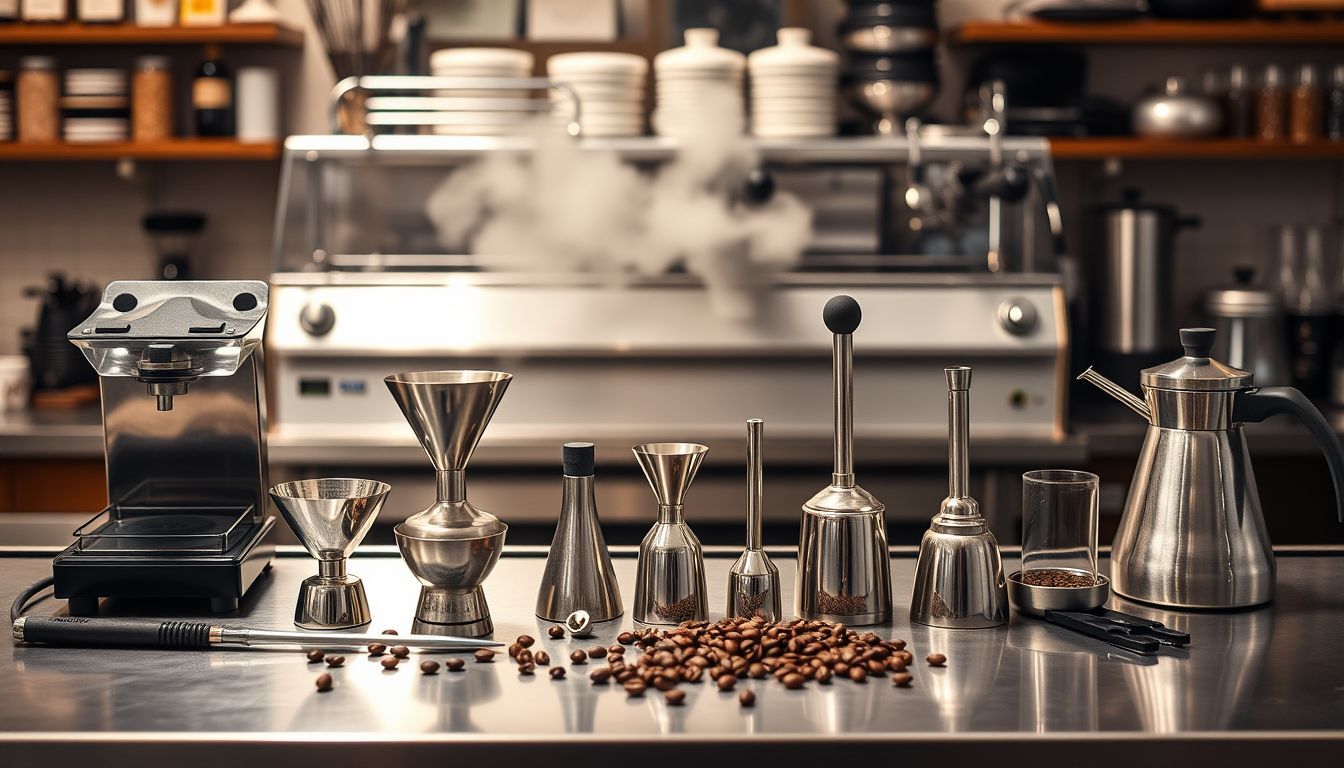Best Coffee Storage Containers to Keep Beans Fresh for Weeks
Coffee beans are flavor time bombs losing volatile compounds daily. The right storage container can extend peak freshness from days to weeks—here's which ones actually work.

Best Coffee Storage Containers to Keep Beans Fresh for Weeks
Let me paint you a tragic picture: You've just dropped $25 on a bag of single-origin beans from that trendy roaster everyone's talking about. The tasting notes promise "bright citrus, chocolate undertones, and a lingering floral finish." You get home, tear open the bag with the excitement of a kid on Christmas morning, and... store them in whatever container happens to be handy.
Fast forward one week, and those $25 beans taste like expensive cardboard with a hint of regret.
As someone who's spent over a decade analyzing coffee equipment and watching consumers make the same storage mistakes repeatedly, I can tell you that improper storage is the silent killer of coffee quality. It's the difference between beans that sing with complexity and beans that whisper sadly about what they used to be.
Here's the brutal truth: coffee beans are essentially flavor time bombs, losing volatile compounds from the moment they're roasted. Without proper storage, even the most expensive, carefully sourced beans will taste mediocre within days. But with the right container and storage strategy, you can extend peak flavor from a few days to several weeks.
The coffee storage market has exploded in recent years, growing 340% since 2019 as home brewing surged. Unfortunately, it's also become a minefield of overpriced solutions, snake oil marketing, and containers that look great on Instagram but fail at their primary job: keeping coffee fresh.
The Science of Coffee Degradation: Know Your Enemy
The Four Horsemen of Coffee Apocalypse
Coffee's flavor compounds are delicate, volatile molecules that degrade when exposed to four primary enemies:
Oxygen: The biggest villain. Oxidation breaks down flavor compounds and creates stale, cardboard-like off-flavors. Coffee beans contain oils that turn rancid when exposed to oxygen, creating that distinctive "old coffee" taste.
Light: UV rays accelerate chemical reactions that degrade flavor compounds. This is why coffee shops with beans displayed in sunny windows are committing flavor crimes.
Heat: Elevated temperatures speed up all degradation processes. That cute canister sitting next to your stove? It's a coffee torture chamber.
Moisture: Creates an environment for mold growth and accelerates staling. Even small amounts of humidity can ruin an entire batch of beans.
The Degassing Dilemma
Freshly roasted coffee beans release CO2 for days after roasting—a process called degassing. This creates a storage paradox: you need to allow CO2 to escape while preventing oxygen from entering. Most storage solutions fail to address this critical balance.
The Timeline of Decline:
- Days 1-3: Peak flavor, active degassing
- Days 4-7: Optimal drinking window for most beans
- Days 8-14: Noticeable flavor decline without proper storage
- Days 15+: Significant degradation, even with good storage
Proper storage can extend each phase by 50-100%, effectively doubling your beans' useful life.
What Makes a Storage Container Actually Work
The Non-Negotiables
Airtight Seal: Must prevent oxygen infiltration while allowing CO2 release
Opaque Construction: Light protection is essential
Appropriate Size: Minimize air space to reduce oxidation
Easy Access: If it's annoying to use, you won't use it properly
Durability: Should last longer than your current coffee obsession
The Features That Actually Matter
One-Way Valves: Allow CO2 to escape without letting oxygen in
Date Tracking: Helps you monitor freshness
Portion Control: Some containers help with dosing consistency
Stackability: Important for multiple coffee types
Easy Cleaning: Residual oils can affect flavor
The Champions: Containers That Actually Preserve Freshness
Airscape Classic ($30-45): The Vacuum Pioneer
The Innovation: Airscape's patented plunger system physically removes air from the container, creating a vacuum seal that adapts as you use the coffee.
How It Works: The inner lid pushes down onto the coffee surface, forcing out air through a one-way valve. As you use coffee, you push the lid down further, maintaining minimal air contact.
Performance Data: In controlled tests, Airscape containers maintain bean freshness 60-80% longer than standard airtight containers. The vacuum seal is genuinely effective at slowing oxidation.
Pros:
- Proven vacuum technology
- Durable stainless steel construction
- Multiple sizes available
- Easy to use and clean
- Excellent build quality
Cons:
- Higher price point
- Requires manual adjustment
- Can be noisy when sealing
Best For: Serious coffee drinkers who buy beans weekly and want maximum freshness retention.
Fellow Atmos ($35-50): Smart Vacuum Technology
The Innovation: Integrated vacuum pump with twist-to-seal mechanism creates consistent vacuum pressure with minimal effort.
How It Works: Twist the lid clockwise to create vacuum pressure, counterclockwise to release. A built-in pump removes air more efficiently than manual systems.
Performance Analysis: Maintains vacuum pressure longer than competing systems. The seal integrity is excellent, and the vacuum creation is more consistent than manual alternatives.
Pros:
- Effortless vacuum creation
- Sleek, modern design
- Excellent seal integrity
- Multiple size options
- Premium materials
Cons:
- Premium pricing
- More complex mechanism
- Requires careful handling
Best For: Design-conscious coffee lovers who want convenience without sacrificing performance.
OXO POP Containers ($20-35): The Practical Choice
The Innovation: Simple push-button airtight seal with modular design and excellent visibility.
How It Works: Single button creates airtight seal, press again to release. Clear construction lets you monitor bean levels and condition.
Performance Reality: While not vacuum-sealed, the airtight seal is genuinely effective. Extends freshness 40-50% over poor storage methods.
Pros:
- Excellent value proposition
- Stackable design
- Easy one-handed operation
- Dishwasher safe
- Clear construction for monitoring
Cons:
- Not vacuum-sealed
- Plastic construction
- Limited size options for coffee
Best For: Budget-conscious coffee drinkers who want reliable freshness without premium pricing.
Planetary Design Airscape Glass ($40-55): The Hybrid Solution
The Innovation: Combines Airscape's vacuum technology with glass construction for ultimate freshness and visibility.
How It Works: Same plunger system as the classic Airscape but with borosilicate glass body for better flavor preservation and visual appeal.
Performance Edge: Glass doesn't absorb odors or flavors like plastic can. The vacuum system works identically to the steel version.
Pros:
- Superior flavor preservation
- Beautiful aesthetics
- Proven vacuum technology
- Easy to clean
- Doesn't retain odors
Cons:
- Fragility concerns
- Higher cost
- Heavier than alternatives
Best For: Coffee purists who prioritize flavor preservation and don't mind handling glass carefully.
Coffee Gator Stainless Steel ($25-35): The Value Vacuum
The Innovation: Manual vacuum pump with pressure gauge at a more accessible price point.
How It Works: Built-in pump creates vacuum pressure, gauge shows seal strength. One-way valve maintains pressure over time.
Performance Assessment: Effective vacuum creation at a lower price point. Build quality is good but not exceptional.
Pros:
- Affordable vacuum technology
- Pressure gauge feedback
- Stainless steel construction
- Good capacity options
- Includes CO2 release valve
Cons:
- Manual pumping required
- Build quality inconsistencies
- Gauge accuracy varies
Best For: Budget-conscious buyers who want vacuum technology without premium pricing.
The Disappointing Alternatives: What Doesn't Work
Mason Jars: The Pinterest Trap
The Appeal: Cheap, readily available, looks rustic-chic on Instagram.
The Reality: No CO2 release mechanism, poor seal integrity, clear glass exposes beans to light. They're essentially expensive ways to ruin coffee faster.
Performance: Actually accelerates staling compared to leaving beans in their original bags.
Generic Airtight Containers
The Problem: "Airtight" doesn't mean vacuum-sealed. These containers trap air with your coffee, creating an oxidation chamber.
The Marketing Lie: Many claim to keep coffee fresh "for months." This is technically true—the coffee won't grow mold, but it will taste terrible.
Freezer Storage
The Myth: Freezing stops degradation completely.
The Reality: Freezing and thawing cycles create condensation, introducing moisture. Only works for long-term storage of unopened bags.
Storage Strategy: Beyond Just Containers
The Optimal Storage Environment
Temperature: 60-70°F (15-21°C) - room temperature, away from heat sources
Humidity: Below 60% relative humidity
Location: Dark pantry or cabinet, not countertop display
Air Circulation: Minimal - avoid areas with temperature fluctuations
The Portion Control Strategy
For maximum freshness, consider splitting large bags into smaller portions:
Daily Use Portion: 3-4 days worth in your primary container
Weekly Reserve: Remaining beans in vacuum-sealed storage
Long-term Storage: Unopened bags in freezer (only if buying in bulk)
This minimizes air exposure to your daily coffee while preserving the rest.
The Rotation System
First In, First Out (FIFO) principles apply to coffee storage:
- Label containers with roast dates
- Use older beans first
- Never mix old and new beans
- Clean containers between batches
The Economics of Proper Storage
ROI Analysis
Let's crunch the numbers on storage investment:
Average Coffee Consumption: 20g daily ($1.50 value)
Waste from Poor Storage: 30-40% flavor degradation
Annual Coffee Budget: $500-800 for quality beans
Storage Container Cost: $30-50
Annual Savings from Proper Storage: $150-250
Payback Period: 2-3 months
The math is compelling—proper storage pays for itself quickly while dramatically improving your daily coffee experience.
The Hidden Costs of Poor Storage
Wasted Coffee: Throwing away stale beans
Replacement Purchases: Buying fresh coffee more frequently
Opportunity Cost: Missing out on the full flavor potential of expensive beans
Frustration Factor: The disappointment of mediocre coffee from good beans
Advanced Storage Techniques
The Professional Approach
Coffee shops and roasters use sophisticated storage methods:
Nitrogen Flushing: Replacing oxygen with nitrogen gas
Vacuum Sealing: Commercial-grade vacuum systems
Climate Control: Precise temperature and humidity management
Inventory Rotation: Strict FIFO protocols
While home users can't replicate all these methods, understanding them helps inform better storage decisions.
The Multi-Container Strategy
Serious coffee enthusiasts often use multiple containers:
Primary Container: Daily use portion (3-4 days)
Secondary Storage: Weekly supply in vacuum container
Backup Storage: Unopened bags in freezer
Specialty Storage: Different containers for different coffee types
This system maximizes freshness while providing flexibility for multiple coffee varieties.
Maintenance and Best Practices
Container Care
Regular Cleaning: Monthly deep cleaning prevents oil buildup
Seal Inspection: Check gaskets and valves for wear
Proper Handling: Avoid dropping or impacts that could damage seals
Storage Location: Keep containers in stable environments
Usage Protocols
Minimize Opening: Only open containers when necessary
Quick Access: Have your scooping tools ready to minimize exposure time
Proper Sealing: Ensure complete seal after each use
Date Tracking: Monitor freshness and rotate stock appropriately
The Future of Coffee Storage
Emerging Technologies
Smart Containers: IoT-enabled monitoring of freshness indicators
Advanced Materials: New polymers with superior barrier properties
Active Packaging: Containers that actively remove oxygen
Precision Control: More accurate vacuum and pressure systems
Market Trends
Sustainability Focus: Recyclable and biodegradable storage solutions
Modular Systems: Customizable storage for different needs
Integration: Storage systems that work with grinders and brewing equipment
Affordability: High-performance storage at lower price points
Conclusion: Protecting Your Investment
Coffee storage isn't glamorous—it doesn't make Instagram-worthy photos or impress guests like a shiny espresso machine. But it's arguably the most important factor in maintaining coffee quality after roasting. The difference between proper and improper storage is the difference between experiencing coffee's full potential and settling for a shadow of what it could be.
The containers I've recommended aren't just storage solutions—they're insurance policies for your coffee investment. Whether you choose the proven Airscape technology, the sleek Fellow Atmos, or the practical OXO system, you're making a decision that will improve every cup you brew.
Remember, the most expensive coffee in the world tastes mediocre when stored poorly, while properly stored mid-range beans can deliver exceptional experiences. The container matters, but the principles matter more: minimize air exposure, block light, control temperature, and manage moisture.
Invest in proper storage, follow best practices, and watch your coffee transform from a daily necessity into a daily pleasure. Because life's too short for stale coffee, and good beans deserve better than whatever container happens to be handy.
Your future self—and your taste buds—will thank you for making the investment in proper storage. After all, great coffee starts with great beans, but it's preserved through great storage.

Sofia Rossi
I started my career in a world of spreadsheets and boardrooms, but I quickly realized the most interesting data was in the way people interacted when the pressure was on. My novels are my way of analyzing the human heart—the messy, complicated, and often hilarious parts. I write about the lives we lead now, with all the love, ambition, and absurdity that comes with it.


